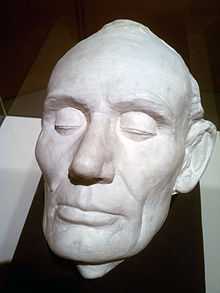Leonard Volk
| Leonard Volk | |
|---|---|
 Memorial of Leonard Volk in Rosehill Cemetery, Chicago, Illinois | |
| Born |
November 7, 1828 Wellstown (now Wells), Hamilton County, New York |
| Died | August 19, 1895 (aged 66) |
| Nationality | American |
| Field | Sculpting |
Leonard Wells Volk (November 7, 1828 – August 19, 1895) was an American sculptor. He is notable for making one of only two life masks of United States President Abraham Lincoln. In 1857 he helped establish the Chicago Academy of Design and served as its president until 1865. He made several large monumental sculptures, including the tomb of the politician Stephen A. Douglas, and statues of American Civil War figures.
Biography

Volk was born at Wellstown (now Wells), Hamilton County, New York to Garrett and Elizabeth (Gesner) Volk. He first followed the trade of a marble cutter with his father in Pittsfield, Massachusetts, where the family moved.[1]
Marriage and family
Before 1855 Volk married Emily Clarissa King Barlow, daughter of Honor (Douglas) and Dr. Jonathan King Barlow of Bethany, New York. A maternal cousin of hers was Stephen A. Douglas, a nationally known politician who ran against Abraham Lincoln for the Republican Party presidential nomination in 1860.[citation needed]
Their son Stephen A. Douglas Volk (1856–1935) as an adult became notable as a figure and portrait painter. He studied under Jean-Léon Gérôme in Paris. Later he helped establish the Minneapolis School of Design.[1]
Career

In 1848 Volk moved west and opened an artist's studio in St Louis, Missouri. From 1855-1857, Stephen A. Douglas, his wife's cousin, supported the family's travel to Rome so that Volk could pursue additional study.[1]
Returning to the United States in 1857, Volk and his family settled in the booming city of Chicago, where he helped to establish the Chicago Academy of Design, precursor to the School of the Art Institute of Chicago. For eight years, he served as its director and taught numerous students, including Elbridge Ayer Burbank, who became noted for his more than 1200 portraits of Native Americans.[citation needed]
In 1860 Volk made a life mask of Abraham Lincoln. Only one other was made, by Clark Mills in 1865.[1] In the early part of spring 1860, during Lincoln's visit to Chicago, Volk asked him to sit for a bust. The artist decided to start by doing a life mask. Lincoln found the process of letting wet plaster dry on his face, followed by a skin-stretching removal process, "anything but agreeable".[citation needed] But he maintained good humor, and was pleased with the final bust. He declared it "the animal himself".[citation needed] Volk later used the life mask and bust of 1860 as the basis for other versions of Lincoln, including a full-size statue. The life mask was also studied by other artists, such as Daniel Chester French.[citation needed]
In mid-May 1860, Volk went to Springfield to present the Lincolns with the completed cabinet bust. He had just received the nomination as presidential candidate for the Republican Party. The following day Volk asked Lincoln to allow a casting of both his hands, for use in other sculptural works. Volk wanted Lincoln to hold something to simulate grasping a document in his right hand. Lincoln came back from his tool shed with a whittled piece of broom handle. The casting for Lincoln's right hand was made as he held the broom handle. Lincoln's left hand was cast slightly closed but empty.[citation needed]

Works
Principal works:[citation needed]
- Stephen A. Douglas Tomb at Chicago, Illinois
- Soldiers' and Sailors' Monument at Rochester, New York
- statues of Abraham Lincoln and Stephen A. Douglas in the Illinois State Capitol at Springfield, Illinois
- statue of General James Shields in Statuary Hall, United States Capitol
- statues of Elihu B. Washburne, Zachariah Chandler and David Davis
Legacy and honors
- 1880, Volk was elected to the Society of American Artists.[citation needed]
- 1899, elected to the National Academy of Design in 1899.[citation needed]
Notes
References
 This article incorporates text from a publication now in the public domain: Chisholm, Hugh, ed. (1911). "Volk, Leonard Wells". Encyclopædia Britannica (11th ed.). Cambridge University Press
This article incorporates text from a publication now in the public domain: Chisholm, Hugh, ed. (1911). "Volk, Leonard Wells". Encyclopædia Britannica (11th ed.). Cambridge University Press
|